Detailed Statement of Work for PHL Website Redesign Project
VerifiedAdded on 2022/10/11
|7
|3115
|12
Project
AI Summary
This document presents a Statement of Work (SOW) for the website redesign project of Pashendale Holdings Ltd (PHL), an Australian construction company. The project aims to enhance PHL's marketing and customer service by revamping its existing website. The SOW outlines the project's scope, which includes developing a new website with features like client testimonials, new construction projects, an affiliate platform, and industry information, all within a user-friendly interface. The work requirements detail the tasks across planning, design, implementation, and conversion phases. The schedule/milestones section defines key deliverables and their deadlines. The pricing section provides a cost breakdown for each project phase, and the acceptance criteria clarify the process for PHL to approve the project deliverables. The project's ultimate goal is to improve customer service and marketing effectiveness, thereby strengthening PHL's market position.
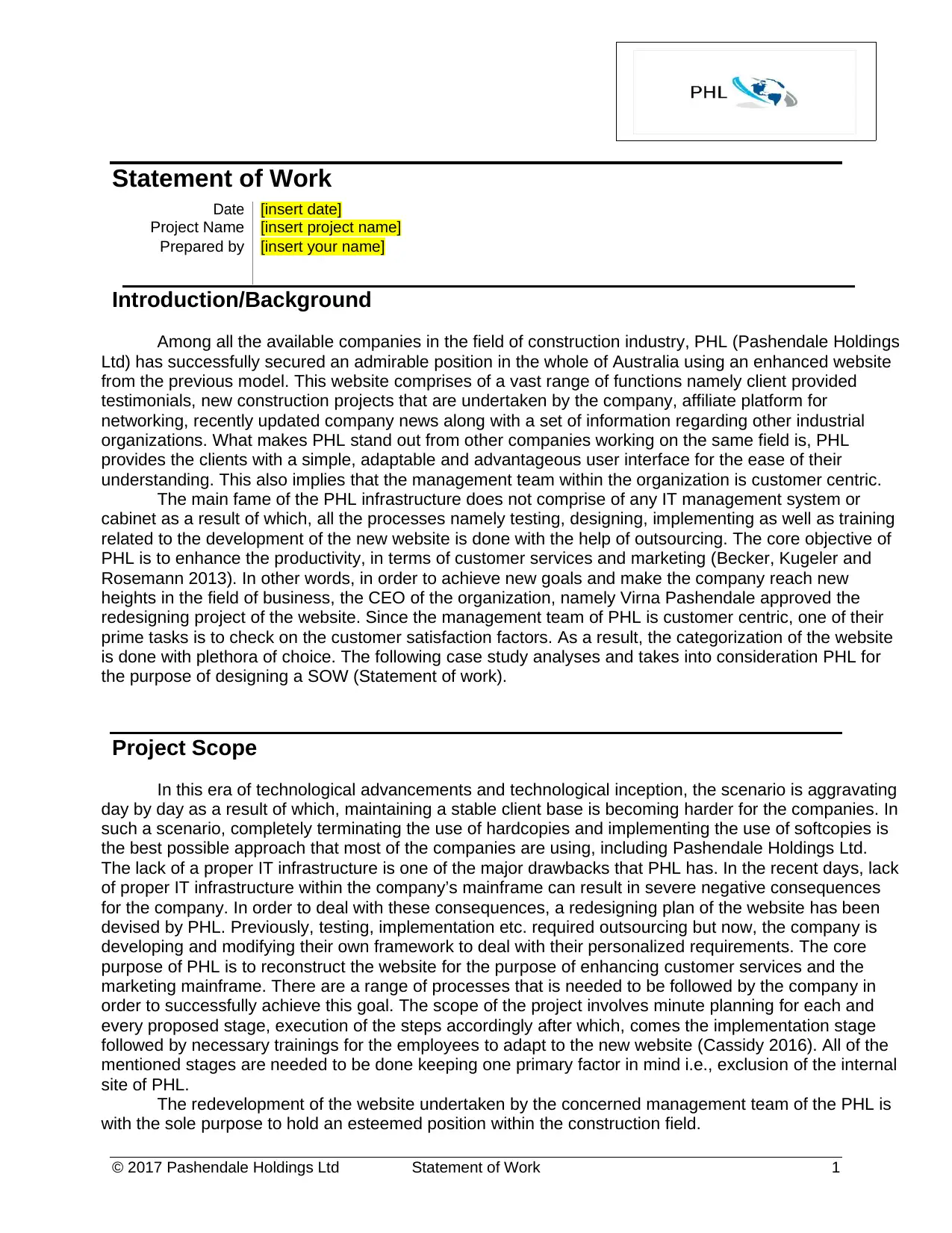
© 2017 Pashendale Holdings Ltd Statement of Work 1
Statement of Work
Date [insert date]
Project Name [insert project name]
Prepared by [insert your name]
Introduction/Background
Among all the available companies in the field of construction industry, PHL (Pashendale Holdings
Ltd) has successfully secured an admirable position in the whole of Australia using an enhanced website
from the previous model. This website comprises of a vast range of functions namely client provided
testimonials, new construction projects that are undertaken by the company, affiliate platform for
networking, recently updated company news along with a set of information regarding other industrial
organizations. What makes PHL stand out from other companies working on the same field is, PHL
provides the clients with a simple, adaptable and advantageous user interface for the ease of their
understanding. This also implies that the management team within the organization is customer centric.
The main fame of the PHL infrastructure does not comprise of any IT management system or
cabinet as a result of which, all the processes namely testing, designing, implementing as well as training
related to the development of the new website is done with the help of outsourcing. The core objective of
PHL is to enhance the productivity, in terms of customer services and marketing (Becker, Kugeler and
Rosemann 2013). In other words, in order to achieve new goals and make the company reach new
heights in the field of business, the CEO of the organization, namely Virna Pashendale approved the
redesigning project of the website. Since the management team of PHL is customer centric, one of their
prime tasks is to check on the customer satisfaction factors. As a result, the categorization of the website
is done with plethora of choice. The following case study analyses and takes into consideration PHL for
the purpose of designing a SOW (Statement of work).
Project Scope
In this era of technological advancements and technological inception, the scenario is aggravating
day by day as a result of which, maintaining a stable client base is becoming harder for the companies. In
such a scenario, completely terminating the use of hardcopies and implementing the use of softcopies is
the best possible approach that most of the companies are using, including Pashendale Holdings Ltd.
The lack of a proper IT infrastructure is one of the major drawbacks that PHL has. In the recent days, lack
of proper IT infrastructure within the company’s mainframe can result in severe negative consequences
for the company. In order to deal with these consequences, a redesigning plan of the website has been
devised by PHL. Previously, testing, implementation etc. required outsourcing but now, the company is
developing and modifying their own framework to deal with their personalized requirements. The core
purpose of PHL is to reconstruct the website for the purpose of enhancing customer services and the
marketing mainframe. There are a range of processes that is needed to be followed by the company in
order to successfully achieve this goal. The scope of the project involves minute planning for each and
every proposed stage, execution of the steps accordingly after which, comes the implementation stage
followed by necessary trainings for the employees to adapt to the new website (Cassidy 2016). All of the
mentioned stages are needed to be done keeping one primary factor in mind i.e., exclusion of the internal
site of PHL.
The redevelopment of the website undertaken by the concerned management team of the PHL is
with the sole purpose to hold an esteemed position within the construction field.
Statement of Work
Date [insert date]
Project Name [insert project name]
Prepared by [insert your name]
Introduction/Background
Among all the available companies in the field of construction industry, PHL (Pashendale Holdings
Ltd) has successfully secured an admirable position in the whole of Australia using an enhanced website
from the previous model. This website comprises of a vast range of functions namely client provided
testimonials, new construction projects that are undertaken by the company, affiliate platform for
networking, recently updated company news along with a set of information regarding other industrial
organizations. What makes PHL stand out from other companies working on the same field is, PHL
provides the clients with a simple, adaptable and advantageous user interface for the ease of their
understanding. This also implies that the management team within the organization is customer centric.
The main fame of the PHL infrastructure does not comprise of any IT management system or
cabinet as a result of which, all the processes namely testing, designing, implementing as well as training
related to the development of the new website is done with the help of outsourcing. The core objective of
PHL is to enhance the productivity, in terms of customer services and marketing (Becker, Kugeler and
Rosemann 2013). In other words, in order to achieve new goals and make the company reach new
heights in the field of business, the CEO of the organization, namely Virna Pashendale approved the
redesigning project of the website. Since the management team of PHL is customer centric, one of their
prime tasks is to check on the customer satisfaction factors. As a result, the categorization of the website
is done with plethora of choice. The following case study analyses and takes into consideration PHL for
the purpose of designing a SOW (Statement of work).
Project Scope
In this era of technological advancements and technological inception, the scenario is aggravating
day by day as a result of which, maintaining a stable client base is becoming harder for the companies. In
such a scenario, completely terminating the use of hardcopies and implementing the use of softcopies is
the best possible approach that most of the companies are using, including Pashendale Holdings Ltd.
The lack of a proper IT infrastructure is one of the major drawbacks that PHL has. In the recent days, lack
of proper IT infrastructure within the company’s mainframe can result in severe negative consequences
for the company. In order to deal with these consequences, a redesigning plan of the website has been
devised by PHL. Previously, testing, implementation etc. required outsourcing but now, the company is
developing and modifying their own framework to deal with their personalized requirements. The core
purpose of PHL is to reconstruct the website for the purpose of enhancing customer services and the
marketing mainframe. There are a range of processes that is needed to be followed by the company in
order to successfully achieve this goal. The scope of the project involves minute planning for each and
every proposed stage, execution of the steps accordingly after which, comes the implementation stage
followed by necessary trainings for the employees to adapt to the new website (Cassidy 2016). All of the
mentioned stages are needed to be done keeping one primary factor in mind i.e., exclusion of the internal
site of PHL.
The redevelopment of the website undertaken by the concerned management team of the PHL is
with the sole purpose to hold an esteemed position within the construction field.
Paraphrase This Document
Need a fresh take? Get an instant paraphrase of this document with our AI Paraphraser
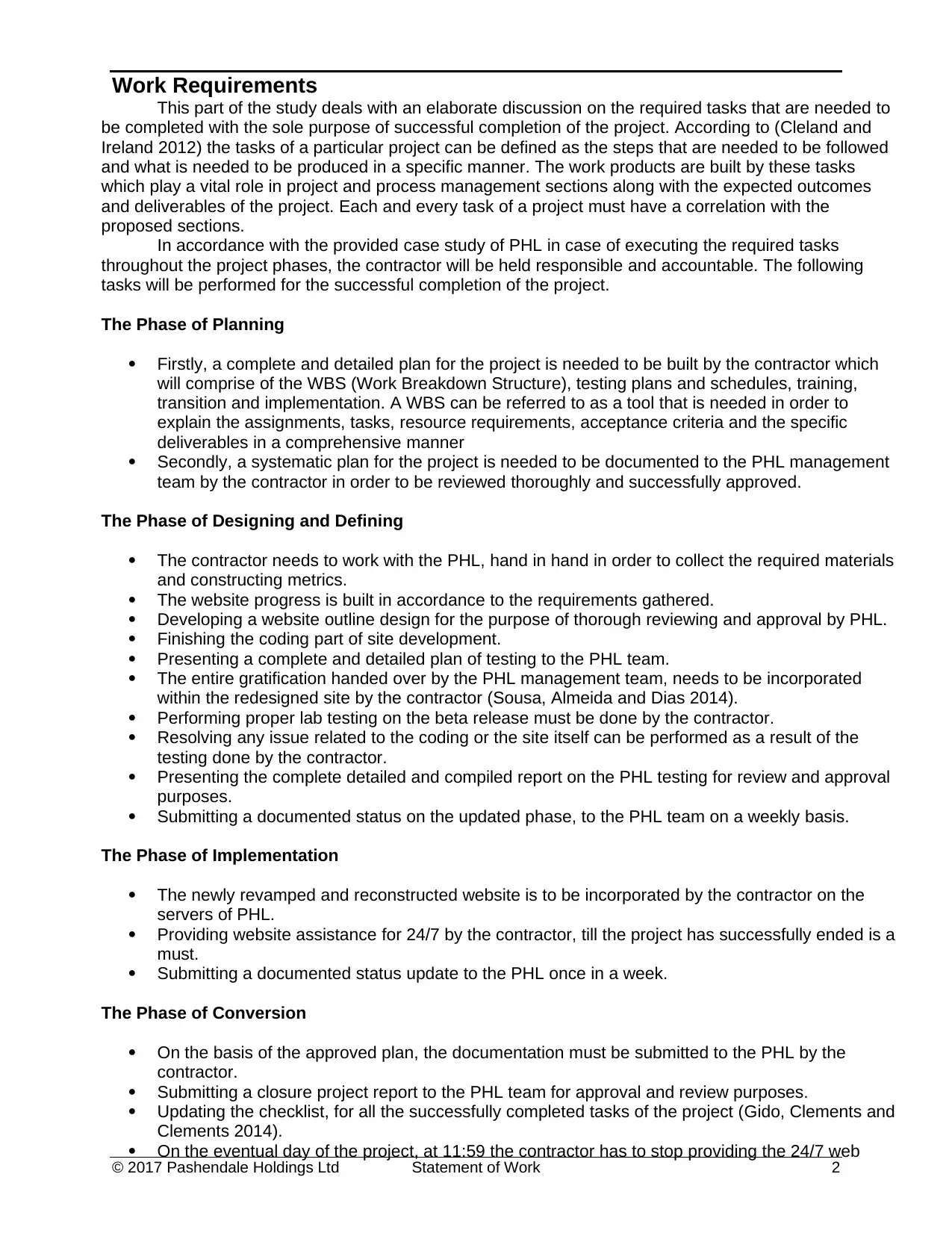
© 2017 Pashendale Holdings Ltd Statement of Work 2
Work Requirements
This part of the study deals with an elaborate discussion on the required tasks that are needed to
be completed with the sole purpose of successful completion of the project. According to (Cleland and
Ireland 2012) the tasks of a particular project can be defined as the steps that are needed to be followed
and what is needed to be produced in a specific manner. The work products are built by these tasks
which play a vital role in project and process management sections along with the expected outcomes
and deliverables of the project. Each and every task of a project must have a correlation with the
proposed sections.
In accordance with the provided case study of PHL in case of executing the required tasks
throughout the project phases, the contractor will be held responsible and accountable. The following
tasks will be performed for the successful completion of the project.
The Phase of Planning
Firstly, a complete and detailed plan for the project is needed to be built by the contractor which
will comprise of the WBS (Work Breakdown Structure), testing plans and schedules, training,
transition and implementation. A WBS can be referred to as a tool that is needed in order to
explain the assignments, tasks, resource requirements, acceptance criteria and the specific
deliverables in a comprehensive manner
Secondly, a systematic plan for the project is needed to be documented to the PHL management
team by the contractor in order to be reviewed thoroughly and successfully approved.
The Phase of Designing and Defining
The contractor needs to work with the PHL, hand in hand in order to collect the required materials
and constructing metrics.
The website progress is built in accordance to the requirements gathered.
Developing a website outline design for the purpose of thorough reviewing and approval by PHL.
Finishing the coding part of site development.
Presenting a complete and detailed plan of testing to the PHL team.
The entire gratification handed over by the PHL management team, needs to be incorporated
within the redesigned site by the contractor (Sousa, Almeida and Dias 2014).
Performing proper lab testing on the beta release must be done by the contractor.
Resolving any issue related to the coding or the site itself can be performed as a result of the
testing done by the contractor.
Presenting the complete detailed and compiled report on the PHL testing for review and approval
purposes.
Submitting a documented status on the updated phase, to the PHL team on a weekly basis.
The Phase of Implementation
The newly revamped and reconstructed website is to be incorporated by the contractor on the
servers of PHL.
Providing website assistance for 24/7 by the contractor, till the project has successfully ended is a
must.
Submitting a documented status update to the PHL once in a week.
The Phase of Conversion
On the basis of the approved plan, the documentation must be submitted to the PHL by the
contractor.
Submitting a closure project report to the PHL team for approval and review purposes.
Updating the checklist, for all the successfully completed tasks of the project (Gido, Clements and
Clements 2014).
On the eventual day of the project, at 11:59 the contractor has to stop providing the 24/7 web
Work Requirements
This part of the study deals with an elaborate discussion on the required tasks that are needed to
be completed with the sole purpose of successful completion of the project. According to (Cleland and
Ireland 2012) the tasks of a particular project can be defined as the steps that are needed to be followed
and what is needed to be produced in a specific manner. The work products are built by these tasks
which play a vital role in project and process management sections along with the expected outcomes
and deliverables of the project. Each and every task of a project must have a correlation with the
proposed sections.
In accordance with the provided case study of PHL in case of executing the required tasks
throughout the project phases, the contractor will be held responsible and accountable. The following
tasks will be performed for the successful completion of the project.
The Phase of Planning
Firstly, a complete and detailed plan for the project is needed to be built by the contractor which
will comprise of the WBS (Work Breakdown Structure), testing plans and schedules, training,
transition and implementation. A WBS can be referred to as a tool that is needed in order to
explain the assignments, tasks, resource requirements, acceptance criteria and the specific
deliverables in a comprehensive manner
Secondly, a systematic plan for the project is needed to be documented to the PHL management
team by the contractor in order to be reviewed thoroughly and successfully approved.
The Phase of Designing and Defining
The contractor needs to work with the PHL, hand in hand in order to collect the required materials
and constructing metrics.
The website progress is built in accordance to the requirements gathered.
Developing a website outline design for the purpose of thorough reviewing and approval by PHL.
Finishing the coding part of site development.
Presenting a complete and detailed plan of testing to the PHL team.
The entire gratification handed over by the PHL management team, needs to be incorporated
within the redesigned site by the contractor (Sousa, Almeida and Dias 2014).
Performing proper lab testing on the beta release must be done by the contractor.
Resolving any issue related to the coding or the site itself can be performed as a result of the
testing done by the contractor.
Presenting the complete detailed and compiled report on the PHL testing for review and approval
purposes.
Submitting a documented status on the updated phase, to the PHL team on a weekly basis.
The Phase of Implementation
The newly revamped and reconstructed website is to be incorporated by the contractor on the
servers of PHL.
Providing website assistance for 24/7 by the contractor, till the project has successfully ended is a
must.
Submitting a documented status update to the PHL once in a week.
The Phase of Conversion
On the basis of the approved plan, the documentation must be submitted to the PHL by the
contractor.
Submitting a closure project report to the PHL team for approval and review purposes.
Updating the checklist, for all the successfully completed tasks of the project (Gido, Clements and
Clements 2014).
On the eventual day of the project, at 11:59 the contractor has to stop providing the 24/7 web
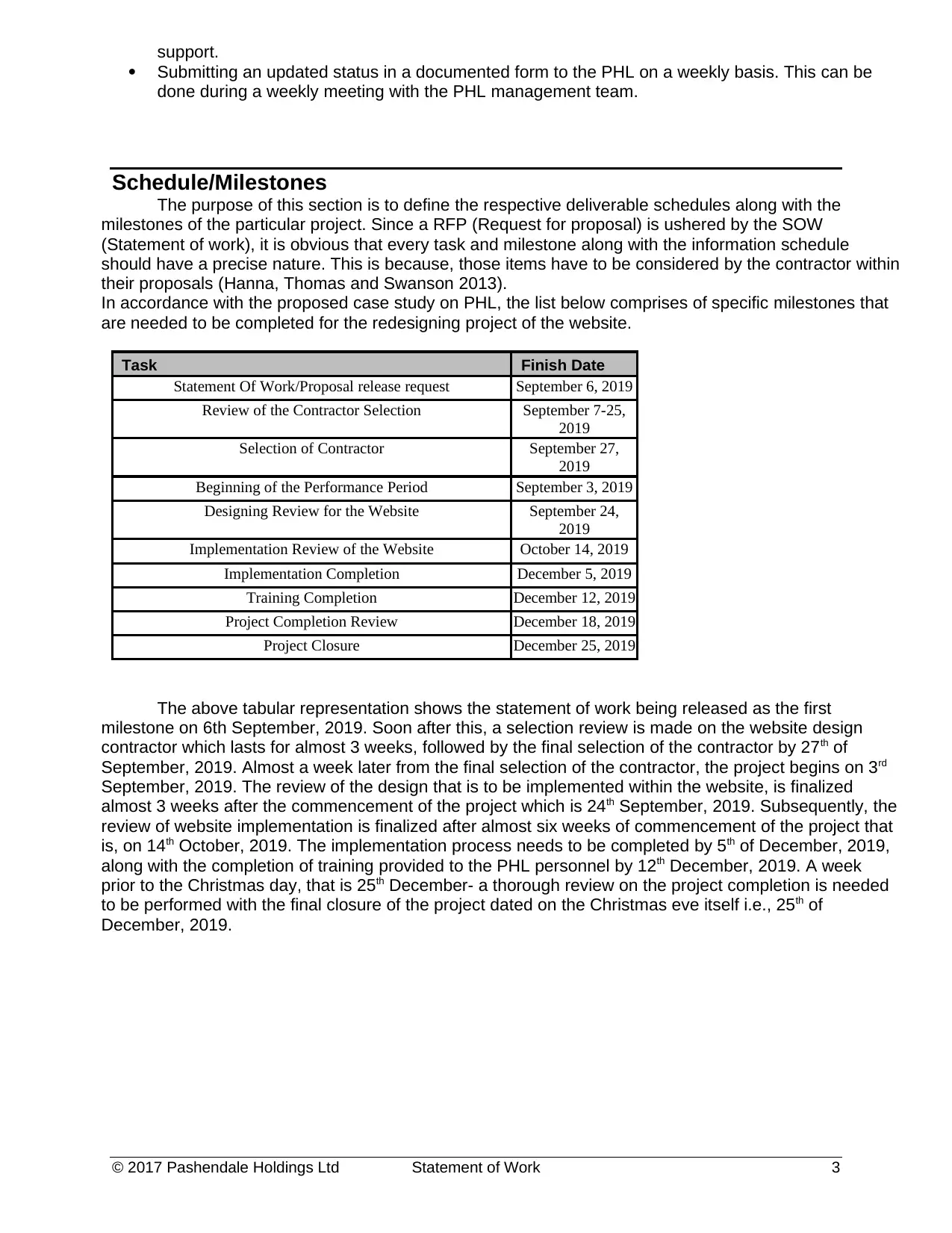
© 2017 Pashendale Holdings Ltd Statement of Work 3
support.
Submitting an updated status in a documented form to the PHL on a weekly basis. This can be
done during a weekly meeting with the PHL management team.
Schedule/Milestones
The purpose of this section is to define the respective deliverable schedules along with the
milestones of the particular project. Since a RFP (Request for proposal) is ushered by the SOW
(Statement of work), it is obvious that every task and milestone along with the information schedule
should have a precise nature. This is because, those items have to be considered by the contractor within
their proposals (Hanna, Thomas and Swanson 2013).
In accordance with the proposed case study on PHL, the list below comprises of specific milestones that
are needed to be completed for the redesigning project of the website.
Task Finish Date
Statement Of Work/Proposal release request September 6, 2019
Review of the Contractor Selection September 7-25,
2019
Selection of Contractor September 27,
2019
Beginning of the Performance Period September 3, 2019
Designing Review for the Website September 24,
2019
Implementation Review of the Website October 14, 2019
Implementation Completion December 5, 2019
Training Completion December 12, 2019
Project Completion Review December 18, 2019
Project Closure December 25, 2019
The above tabular representation shows the statement of work being released as the first
milestone on 6th September, 2019. Soon after this, a selection review is made on the website design
contractor which lasts for almost 3 weeks, followed by the final selection of the contractor by 27th of
September, 2019. Almost a week later from the final selection of the contractor, the project begins on 3rd
September, 2019. The review of the design that is to be implemented within the website, is finalized
almost 3 weeks after the commencement of the project which is 24th September, 2019. Subsequently, the
review of website implementation is finalized after almost six weeks of commencement of the project that
is, on 14th October, 2019. The implementation process needs to be completed by 5th of December, 2019,
along with the completion of training provided to the PHL personnel by 12th December, 2019. A week
prior to the Christmas day, that is 25th December- a thorough review on the project completion is needed
to be performed with the final closure of the project dated on the Christmas eve itself i.e., 25th of
December, 2019.
support.
Submitting an updated status in a documented form to the PHL on a weekly basis. This can be
done during a weekly meeting with the PHL management team.
Schedule/Milestones
The purpose of this section is to define the respective deliverable schedules along with the
milestones of the particular project. Since a RFP (Request for proposal) is ushered by the SOW
(Statement of work), it is obvious that every task and milestone along with the information schedule
should have a precise nature. This is because, those items have to be considered by the contractor within
their proposals (Hanna, Thomas and Swanson 2013).
In accordance with the proposed case study on PHL, the list below comprises of specific milestones that
are needed to be completed for the redesigning project of the website.
Task Finish Date
Statement Of Work/Proposal release request September 6, 2019
Review of the Contractor Selection September 7-25,
2019
Selection of Contractor September 27,
2019
Beginning of the Performance Period September 3, 2019
Designing Review for the Website September 24,
2019
Implementation Review of the Website October 14, 2019
Implementation Completion December 5, 2019
Training Completion December 12, 2019
Project Completion Review December 18, 2019
Project Closure December 25, 2019
The above tabular representation shows the statement of work being released as the first
milestone on 6th September, 2019. Soon after this, a selection review is made on the website design
contractor which lasts for almost 3 weeks, followed by the final selection of the contractor by 27th of
September, 2019. Almost a week later from the final selection of the contractor, the project begins on 3rd
September, 2019. The review of the design that is to be implemented within the website, is finalized
almost 3 weeks after the commencement of the project which is 24th September, 2019. Subsequently, the
review of website implementation is finalized after almost six weeks of commencement of the project that
is, on 14th October, 2019. The implementation process needs to be completed by 5th of December, 2019,
along with the completion of training provided to the PHL personnel by 12th December, 2019. A week
prior to the Christmas day, that is 25th December- a thorough review on the project completion is needed
to be performed with the final closure of the project dated on the Christmas eve itself i.e., 25th of
December, 2019.
⊘ This is a preview!⊘
Do you want full access?
Subscribe today to unlock all pages.

Trusted by 1+ million students worldwide
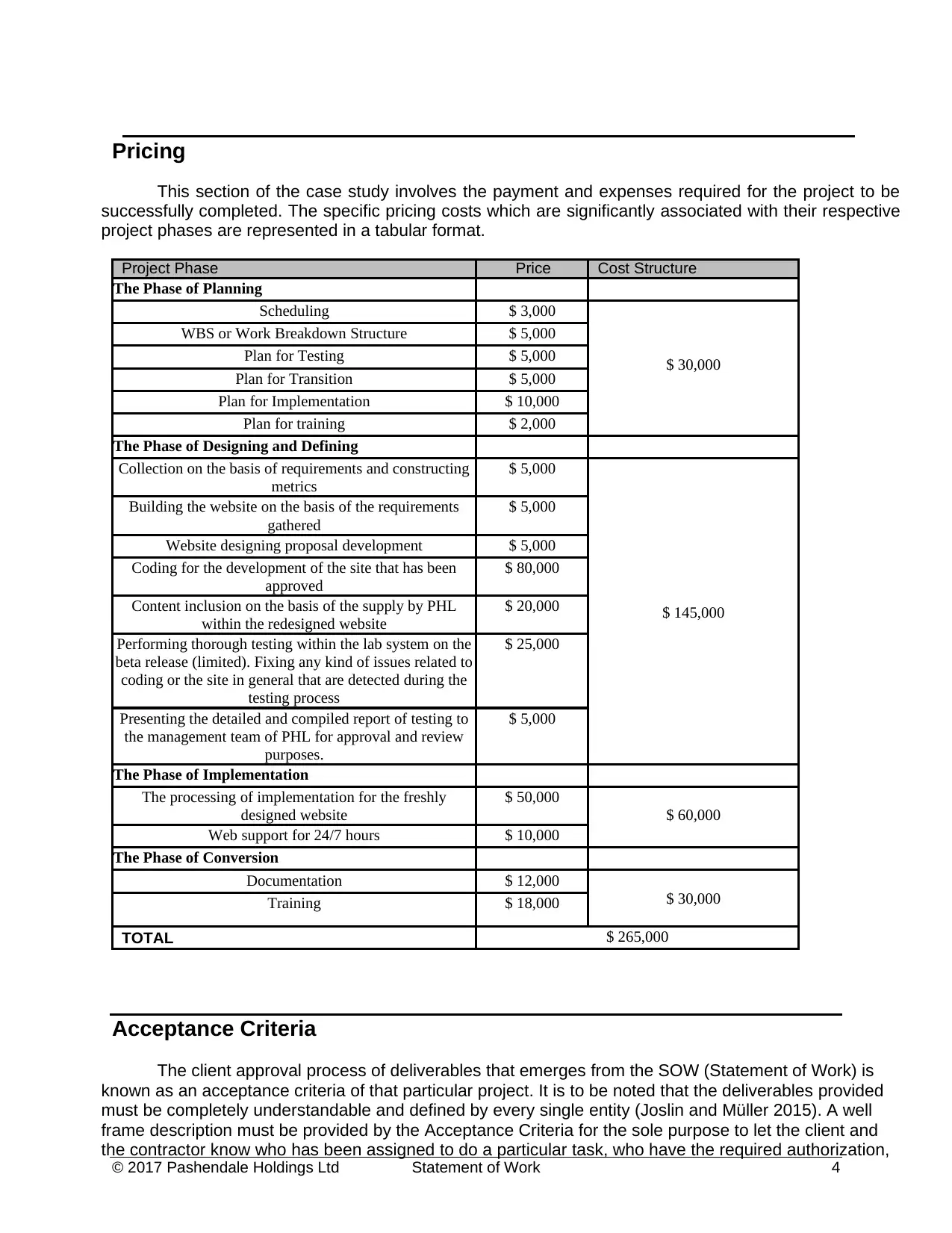
4Statement of Work© 2017 Pashendale Holdings Ltd
Pricing
This section of the case study involves the payment and expenses required for the project to be
successfully completed. The specific pricing costs which are significantly associated with their respective
project phases are represented in a tabular format.
Project Phase Price Cost Structure
The Phase of Planning
Scheduling $ 3,000
$ 30,000
WBS or Work Breakdown Structure $ 5,000
Plan for Testing $ 5,000
Plan for Transition $ 5,000
Plan for Implementation $ 10,000
Plan for training $ 2,000
The Phase of Designing and Defining
Collection on the basis of requirements and constructing
metrics
$ 5,000
$ 145,000
Building the website on the basis of the requirements
gathered
$ 5,000
Website designing proposal development $ 5,000
Coding for the development of the site that has been
approved
$ 80,000
Content inclusion on the basis of the supply by PHL
within the redesigned website
$ 20,000
Performing thorough testing within the lab system on the
beta release (limited). Fixing any kind of issues related to
coding or the site in general that are detected during the
testing process
$ 25,000
Presenting the detailed and compiled report of testing to
the management team of PHL for approval and review
purposes.
$ 5,000
The Phase of Implementation
The processing of implementation for the freshly
designed website
$ 50,000
$ 60,000
Web support for 24/7 hours $ 10,000
The Phase of Conversion
Documentation $ 12,000
$ 30,000Training $ 18,000
TOTAL $ 265,000
Acceptance Criteria
The client approval process of deliverables that emerges from the SOW (Statement of Work) is
known as an acceptance criteria of that particular project. It is to be noted that the deliverables provided
must be completely understandable and defined by every single entity (Joslin and Müller 2015). A well
frame description must be provided by the Acceptance Criteria for the sole purpose to let the client and
the contractor know who has been assigned to do a particular task, who have the required authorization,
Pricing
This section of the case study involves the payment and expenses required for the project to be
successfully completed. The specific pricing costs which are significantly associated with their respective
project phases are represented in a tabular format.
Project Phase Price Cost Structure
The Phase of Planning
Scheduling $ 3,000
$ 30,000
WBS or Work Breakdown Structure $ 5,000
Plan for Testing $ 5,000
Plan for Transition $ 5,000
Plan for Implementation $ 10,000
Plan for training $ 2,000
The Phase of Designing and Defining
Collection on the basis of requirements and constructing
metrics
$ 5,000
$ 145,000
Building the website on the basis of the requirements
gathered
$ 5,000
Website designing proposal development $ 5,000
Coding for the development of the site that has been
approved
$ 80,000
Content inclusion on the basis of the supply by PHL
within the redesigned website
$ 20,000
Performing thorough testing within the lab system on the
beta release (limited). Fixing any kind of issues related to
coding or the site in general that are detected during the
testing process
$ 25,000
Presenting the detailed and compiled report of testing to
the management team of PHL for approval and review
purposes.
$ 5,000
The Phase of Implementation
The processing of implementation for the freshly
designed website
$ 50,000
$ 60,000
Web support for 24/7 hours $ 10,000
The Phase of Conversion
Documentation $ 12,000
$ 30,000Training $ 18,000
TOTAL $ 265,000
Acceptance Criteria
The client approval process of deliverables that emerges from the SOW (Statement of Work) is
known as an acceptance criteria of that particular project. It is to be noted that the deliverables provided
must be completely understandable and defined by every single entity (Joslin and Müller 2015). A well
frame description must be provided by the Acceptance Criteria for the sole purpose to let the client and
the contractor know who has been assigned to do a particular task, who have the required authorization,
Paraphrase This Document
Need a fresh take? Get an instant paraphrase of this document with our AI Paraphraser
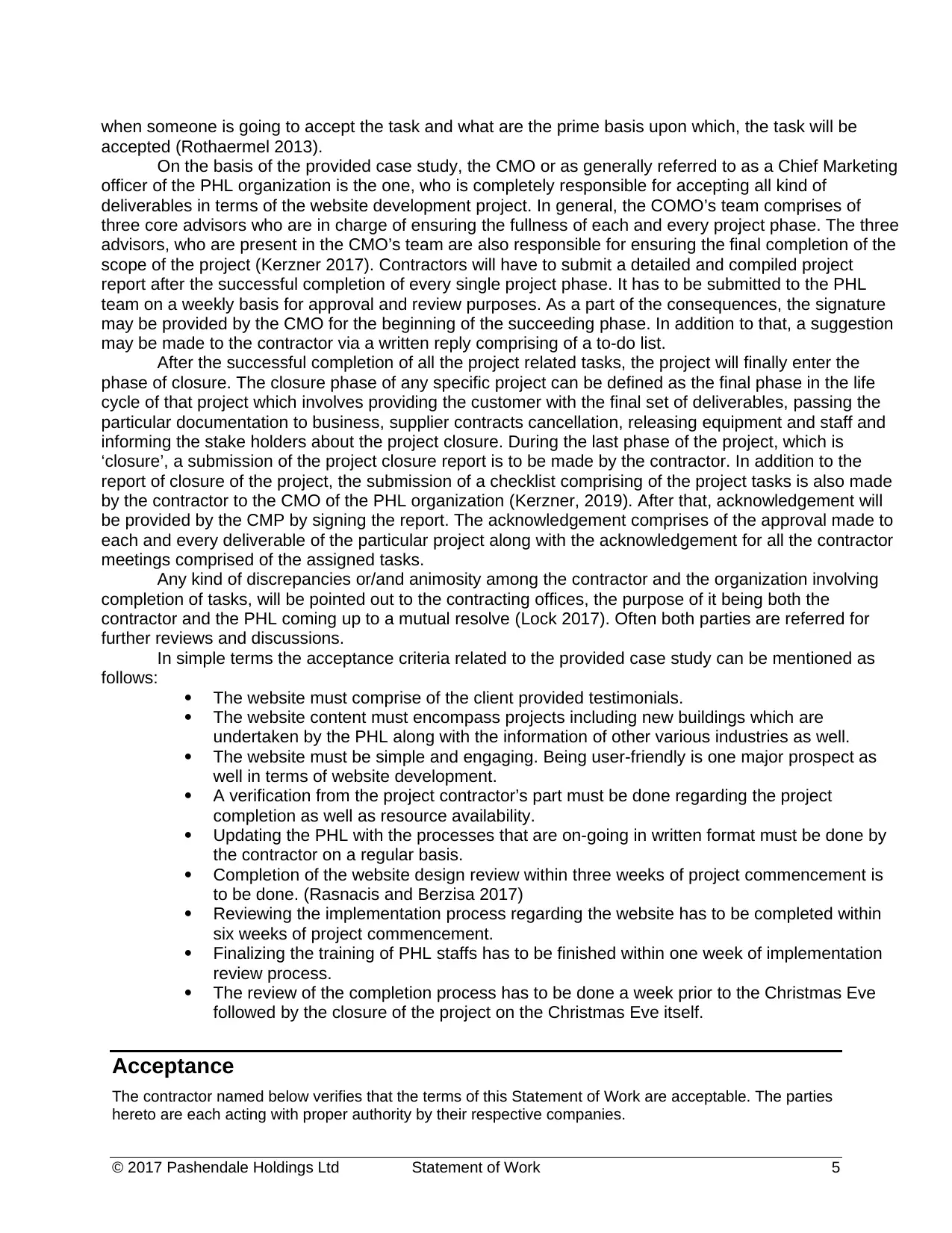
5Statement of Work© 2017 Pashendale Holdings Ltd
when someone is going to accept the task and what are the prime basis upon which, the task will be
accepted (Rothaermel 2013).
On the basis of the provided case study, the CMO or as generally referred to as a Chief Marketing
officer of the PHL organization is the one, who is completely responsible for accepting all kind of
deliverables in terms of the website development project. In general, the COMO’s team comprises of
three core advisors who are in charge of ensuring the fullness of each and every project phase. The three
advisors, who are present in the CMO’s team are also responsible for ensuring the final completion of the
scope of the project (Kerzner 2017). Contractors will have to submit a detailed and compiled project
report after the successful completion of every single project phase. It has to be submitted to the PHL
team on a weekly basis for approval and review purposes. As a part of the consequences, the signature
may be provided by the CMO for the beginning of the succeeding phase. In addition to that, a suggestion
may be made to the contractor via a written reply comprising of a to-do list.
After the successful completion of all the project related tasks, the project will finally enter the
phase of closure. The closure phase of any specific project can be defined as the final phase in the life
cycle of that project which involves providing the customer with the final set of deliverables, passing the
particular documentation to business, supplier contracts cancellation, releasing equipment and staff and
informing the stake holders about the project closure. During the last phase of the project, which is
‘closure’, a submission of the project closure report is to be made by the contractor. In addition to the
report of closure of the project, the submission of a checklist comprising of the project tasks is also made
by the contractor to the CMO of the PHL organization (Kerzner, 2019). After that, acknowledgement will
be provided by the CMP by signing the report. The acknowledgement comprises of the approval made to
each and every deliverable of the particular project along with the acknowledgement for all the contractor
meetings comprised of the assigned tasks.
Any kind of discrepancies or/and animosity among the contractor and the organization involving
completion of tasks, will be pointed out to the contracting offices, the purpose of it being both the
contractor and the PHL coming up to a mutual resolve (Lock 2017). Often both parties are referred for
further reviews and discussions.
In simple terms the acceptance criteria related to the provided case study can be mentioned as
follows:
The website must comprise of the client provided testimonials.
The website content must encompass projects including new buildings which are
undertaken by the PHL along with the information of other various industries as well.
The website must be simple and engaging. Being user-friendly is one major prospect as
well in terms of website development.
A verification from the project contractor’s part must be done regarding the project
completion as well as resource availability.
Updating the PHL with the processes that are on-going in written format must be done by
the contractor on a regular basis.
Completion of the website design review within three weeks of project commencement is
to be done. (Rasnacis and Berzisa 2017)
Reviewing the implementation process regarding the website has to be completed within
six weeks of project commencement.
Finalizing the training of PHL staffs has to be finished within one week of implementation
review process.
The review of the completion process has to be done a week prior to the Christmas Eve
followed by the closure of the project on the Christmas Eve itself.
Acceptance
The contractor named below verifies that the terms of this Statement of Work are acceptable. The parties
hereto are each acting with proper authority by their respective companies.
when someone is going to accept the task and what are the prime basis upon which, the task will be
accepted (Rothaermel 2013).
On the basis of the provided case study, the CMO or as generally referred to as a Chief Marketing
officer of the PHL organization is the one, who is completely responsible for accepting all kind of
deliverables in terms of the website development project. In general, the COMO’s team comprises of
three core advisors who are in charge of ensuring the fullness of each and every project phase. The three
advisors, who are present in the CMO’s team are also responsible for ensuring the final completion of the
scope of the project (Kerzner 2017). Contractors will have to submit a detailed and compiled project
report after the successful completion of every single project phase. It has to be submitted to the PHL
team on a weekly basis for approval and review purposes. As a part of the consequences, the signature
may be provided by the CMO for the beginning of the succeeding phase. In addition to that, a suggestion
may be made to the contractor via a written reply comprising of a to-do list.
After the successful completion of all the project related tasks, the project will finally enter the
phase of closure. The closure phase of any specific project can be defined as the final phase in the life
cycle of that project which involves providing the customer with the final set of deliverables, passing the
particular documentation to business, supplier contracts cancellation, releasing equipment and staff and
informing the stake holders about the project closure. During the last phase of the project, which is
‘closure’, a submission of the project closure report is to be made by the contractor. In addition to the
report of closure of the project, the submission of a checklist comprising of the project tasks is also made
by the contractor to the CMO of the PHL organization (Kerzner, 2019). After that, acknowledgement will
be provided by the CMP by signing the report. The acknowledgement comprises of the approval made to
each and every deliverable of the particular project along with the acknowledgement for all the contractor
meetings comprised of the assigned tasks.
Any kind of discrepancies or/and animosity among the contractor and the organization involving
completion of tasks, will be pointed out to the contracting offices, the purpose of it being both the
contractor and the PHL coming up to a mutual resolve (Lock 2017). Often both parties are referred for
further reviews and discussions.
In simple terms the acceptance criteria related to the provided case study can be mentioned as
follows:
The website must comprise of the client provided testimonials.
The website content must encompass projects including new buildings which are
undertaken by the PHL along with the information of other various industries as well.
The website must be simple and engaging. Being user-friendly is one major prospect as
well in terms of website development.
A verification from the project contractor’s part must be done regarding the project
completion as well as resource availability.
Updating the PHL with the processes that are on-going in written format must be done by
the contractor on a regular basis.
Completion of the website design review within three weeks of project commencement is
to be done. (Rasnacis and Berzisa 2017)
Reviewing the implementation process regarding the website has to be completed within
six weeks of project commencement.
Finalizing the training of PHL staffs has to be finished within one week of implementation
review process.
The review of the completion process has to be done a week prior to the Christmas Eve
followed by the closure of the project on the Christmas Eve itself.
Acceptance
The contractor named below verifies that the terms of this Statement of Work are acceptable. The parties
hereto are each acting with proper authority by their respective companies.
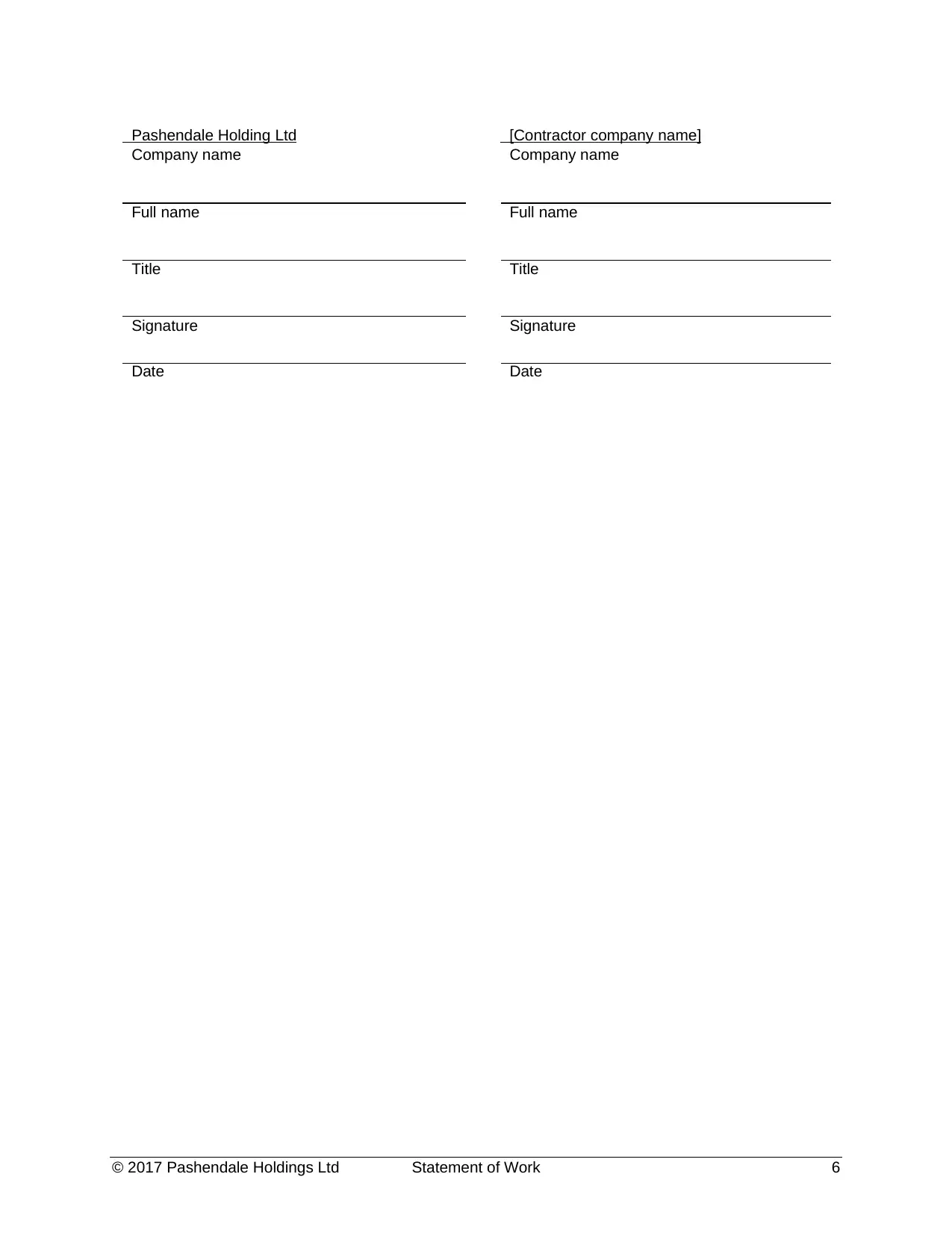
6Statement of Work© 2017 Pashendale Holdings Ltd
Pashendale Holding Ltd [Contractor company name]
Company name Company name
Full name Full name
Title Title
Signature Signature
Date Date
Pashendale Holding Ltd [Contractor company name]
Company name Company name
Full name Full name
Title Title
Signature Signature
Date Date
⊘ This is a preview!⊘
Do you want full access?
Subscribe today to unlock all pages.

Trusted by 1+ million students worldwide
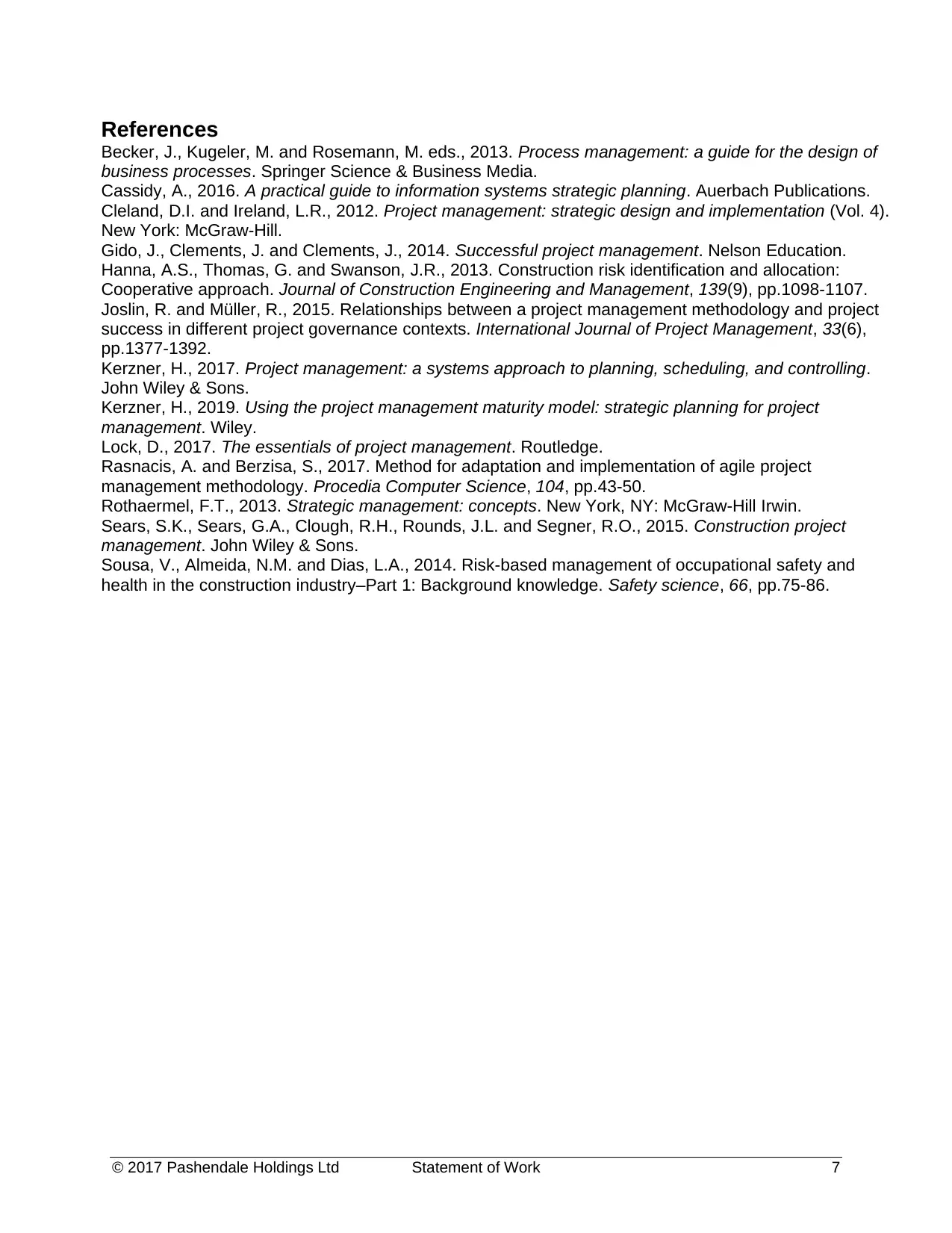
7Statement of Work© 2017 Pashendale Holdings Ltd
References
Becker, J., Kugeler, M. and Rosemann, M. eds., 2013. Process management: a guide for the design of
business processes. Springer Science & Business Media.
Cassidy, A., 2016. A practical guide to information systems strategic planning. Auerbach Publications.
Cleland, D.I. and Ireland, L.R., 2012. Project management: strategic design and implementation (Vol. 4).
New York: McGraw-Hill.
Gido, J., Clements, J. and Clements, J., 2014. Successful project management. Nelson Education.
Hanna, A.S., Thomas, G. and Swanson, J.R., 2013. Construction risk identification and allocation:
Cooperative approach. Journal of Construction Engineering and Management, 139(9), pp.1098-1107.
Joslin, R. and Müller, R., 2015. Relationships between a project management methodology and project
success in different project governance contexts. International Journal of Project Management, 33(6),
pp.1377-1392.
Kerzner, H., 2017. Project management: a systems approach to planning, scheduling, and controlling.
John Wiley & Sons.
Kerzner, H., 2019. Using the project management maturity model: strategic planning for project
management. Wiley.
Lock, D., 2017. The essentials of project management. Routledge.
Rasnacis, A. and Berzisa, S., 2017. Method for adaptation and implementation of agile project
management methodology. Procedia Computer Science, 104, pp.43-50.
Rothaermel, F.T., 2013. Strategic management: concepts. New York, NY: McGraw-Hill Irwin.
Sears, S.K., Sears, G.A., Clough, R.H., Rounds, J.L. and Segner, R.O., 2015. Construction project
management. John Wiley & Sons.
Sousa, V., Almeida, N.M. and Dias, L.A., 2014. Risk-based management of occupational safety and
health in the construction industry–Part 1: Background knowledge. Safety science, 66, pp.75-86.
References
Becker, J., Kugeler, M. and Rosemann, M. eds., 2013. Process management: a guide for the design of
business processes. Springer Science & Business Media.
Cassidy, A., 2016. A practical guide to information systems strategic planning. Auerbach Publications.
Cleland, D.I. and Ireland, L.R., 2012. Project management: strategic design and implementation (Vol. 4).
New York: McGraw-Hill.
Gido, J., Clements, J. and Clements, J., 2014. Successful project management. Nelson Education.
Hanna, A.S., Thomas, G. and Swanson, J.R., 2013. Construction risk identification and allocation:
Cooperative approach. Journal of Construction Engineering and Management, 139(9), pp.1098-1107.
Joslin, R. and Müller, R., 2015. Relationships between a project management methodology and project
success in different project governance contexts. International Journal of Project Management, 33(6),
pp.1377-1392.
Kerzner, H., 2017. Project management: a systems approach to planning, scheduling, and controlling.
John Wiley & Sons.
Kerzner, H., 2019. Using the project management maturity model: strategic planning for project
management. Wiley.
Lock, D., 2017. The essentials of project management. Routledge.
Rasnacis, A. and Berzisa, S., 2017. Method for adaptation and implementation of agile project
management methodology. Procedia Computer Science, 104, pp.43-50.
Rothaermel, F.T., 2013. Strategic management: concepts. New York, NY: McGraw-Hill Irwin.
Sears, S.K., Sears, G.A., Clough, R.H., Rounds, J.L. and Segner, R.O., 2015. Construction project
management. John Wiley & Sons.
Sousa, V., Almeida, N.M. and Dias, L.A., 2014. Risk-based management of occupational safety and
health in the construction industry–Part 1: Background knowledge. Safety science, 66, pp.75-86.
1 out of 7
Related Documents
Your All-in-One AI-Powered Toolkit for Academic Success.
+13062052269
info@desklib.com
Available 24*7 on WhatsApp / Email
![[object Object]](/_next/static/media/star-bottom.7253800d.svg)
Unlock your academic potential
Copyright © 2020–2025 A2Z Services. All Rights Reserved. Developed and managed by ZUCOL.





